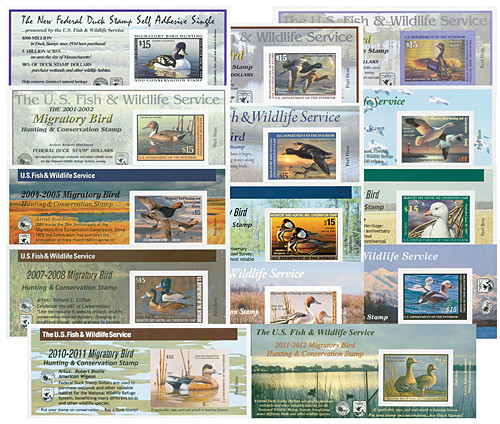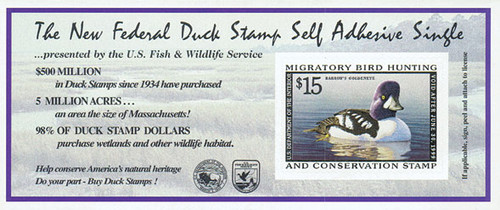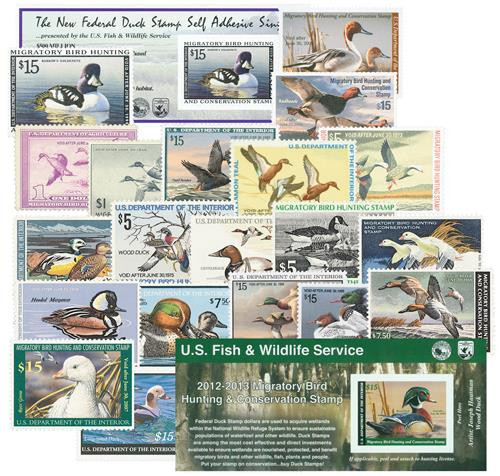
# RW65A//RW79A - 1998-2012 Federal Duck Stamp - US Duck Stamps s/a 15v Mint
Collect the First “Experimental” Duck Stamps
In 1998, the Department of the Interior issued the first self-adhesive Duck Stamp. Reportedly the new self-adhesive stamps were made dollar-bill size so they could fit securely in the cash drawers of Wal-Mart’s sporting goods departments. Collectors loved the new format. Now you can get the first 15 self-adhesive duck stamps for your collection. Read on to discover more of the history behind these stamps…
Created by the Nation’s Greatest Wildlife Artists
Famous cartoonist and conservationist Jay N. Darling was responsible for the concept of “Duck Stamps” (also known as Hunting Permit stamps) as well as the artwork for the first issue. Darling put his cartooning aside in 1934 and ’35 to serve as chief of the Biological Service – a forerunner to the Fish and Wildlife Service. There he thought of issuing Duck Stamps to raise money for the purchase of wetlands.
The first Duck Stamp contest began in 1949. A US Fish and Wildlife press release from January 1950 proclaimed it the first open national competition, with any US artist allowed to enter their artwork. To select each year’s design, a panel of noted art, waterfowl and philatelic authorities are assembled for judging by the Secretary of the Interior. This means only the very best duck artwork is chosen for these stamps.
Beautiful and Meaningful...
Duck Stamps Help Preserve America’s Wetlands
Since 1934, Federal Duck Stamps have generated more than $800 million of funds used to purchase over 6 million acres of waterfowl habitat in America. These preserves do more than help waterfowl – other species have prospered because of the Duck Stamp program.
And people benefit, too. Outdoor enthusiasts gain a place to enjoy nature’s beauty. Wetlands also help purify water systems, store floodwater and nourish fish hatchlings. This program works wonders.
These stamps were issued in limited quantity, so send for yours right away.
Set includes: RW65A, RW66A, RW67A, RW68A, RW69A, RW70A, RW71A, RW72A, RW73A, RW74A, RW75A, RW76A, RW77A, RW78A, and RW79A.
Collect the First “Experimental” Duck Stamps
In 1998, the Department of the Interior issued the first self-adhesive Duck Stamp. Reportedly the new self-adhesive stamps were made dollar-bill size so they could fit securely in the cash drawers of Wal-Mart’s sporting goods departments. Collectors loved the new format. Now you can get the first 15 self-adhesive duck stamps for your collection. Read on to discover more of the history behind these stamps…
Created by the Nation’s Greatest Wildlife Artists
Famous cartoonist and conservationist Jay N. Darling was responsible for the concept of “Duck Stamps” (also known as Hunting Permit stamps) as well as the artwork for the first issue. Darling put his cartooning aside in 1934 and ’35 to serve as chief of the Biological Service – a forerunner to the Fish and Wildlife Service. There he thought of issuing Duck Stamps to raise money for the purchase of wetlands.
The first Duck Stamp contest began in 1949. A US Fish and Wildlife press release from January 1950 proclaimed it the first open national competition, with any US artist allowed to enter their artwork. To select each year’s design, a panel of noted art, waterfowl and philatelic authorities are assembled for judging by the Secretary of the Interior. This means only the very best duck artwork is chosen for these stamps.
Beautiful and Meaningful...
Duck Stamps Help Preserve America’s Wetlands
Since 1934, Federal Duck Stamps have generated more than $800 million of funds used to purchase over 6 million acres of waterfowl habitat in America. These preserves do more than help waterfowl – other species have prospered because of the Duck Stamp program.
And people benefit, too. Outdoor enthusiasts gain a place to enjoy nature’s beauty. Wetlands also help purify water systems, store floodwater and nourish fish hatchlings. This program works wonders.
These stamps were issued in limited quantity, so send for yours right away.
Set includes: RW65A, RW66A, RW67A, RW68A, RW69A, RW70A, RW71A, RW72A, RW73A, RW74A, RW75A, RW76A, RW77A, RW78A, and RW79A.











